LAFF Home Non-lichenized Ascomycota Rusts, smuts, and allies Lichens and lichenicolous fungi Month-by-month Habitats
Top 100 Candidate species for targeted surveys - larger Basidiomycota
Information on the target species will be developed over the coming months. The table below contains those that are already featured in this website...
| Species (links to species information) | Associated organisms/substrata | When to look | Localities | Last recorded (pre project) | Successful search (during project lifespan) | British sites | ||||
| Pre-1965 | 1965-June 2014 | July 2014-present (LAFF) | Extant (since 1965) | |||||||
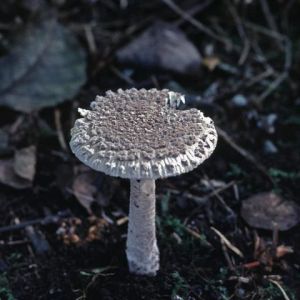 |
Amanita friabilis | in damp woodland soil associated with Alnus | Sept | In Britain and Ireland, verified and DNA-sequenced voucher specimens are known only from one site in Cumbria (England) and one in Antrim (Ireland). Many other voucher specimens at Kew have been redetermined. | 2013 | 0 | 1 | 0 | 1 | |
 |
PDF - Species Datasheet |
Ectomycorrhizal with Salix herbacea in montane dwarf shrub communities | Jun-Oct | Fairly widespread but infrequently recorded from the Grampians and North-West Highlands of Scotland, the Lake District in Cumbria, and Snowdonia in Caernarvonshire. | 2013 | Yes | 4 | 23 | 9 | 27 |
 |
Amanita ovoidea | Under Quercus ilex, and in calcareous grassland with Helianthemum | Jul-Oct | Wiltshire and Isle of Wight | 2010 | Yes | 0 | 2 | 1 | 2 |
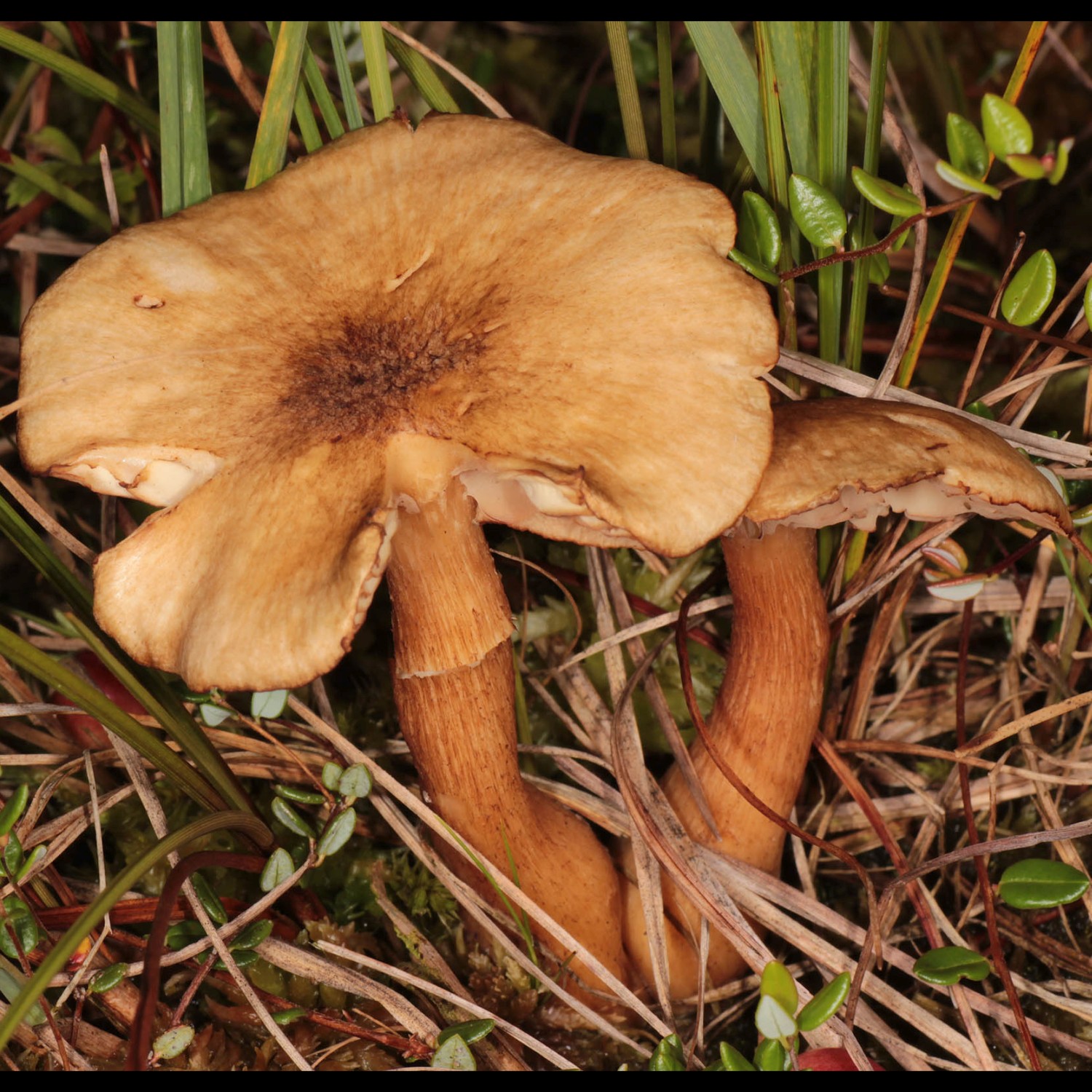 |
Armillaria ectypa | In marshes, upland bogs and reed beds | Jul-Oct | Scattered throughout Great Britain and Northern Ireland | 2009 | Yes | 0 | 8 | 6 | 12 |
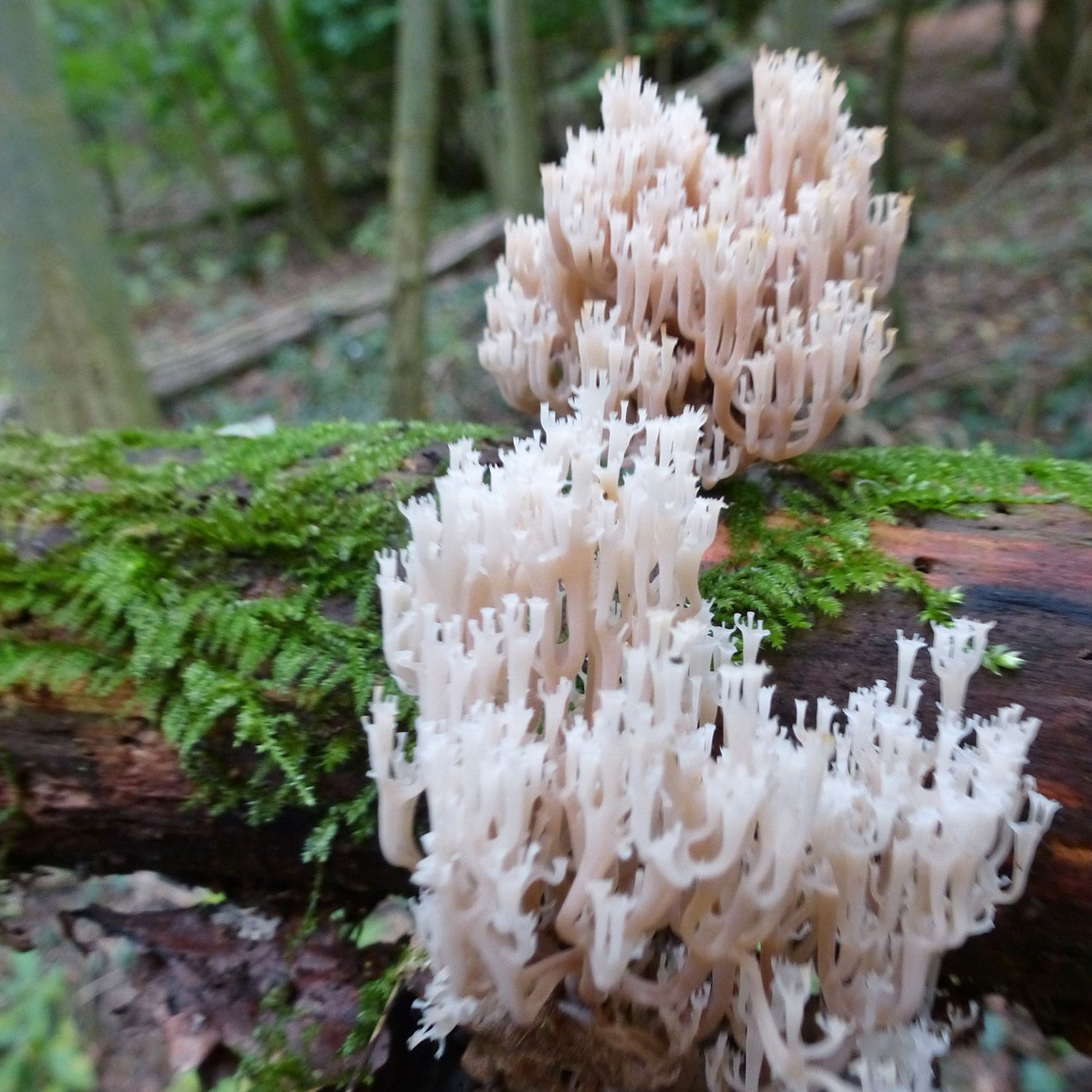 |
Artomyces pyxidatus | An elegantly whorled white to yellow to brown coral fungus with distinctive crown-like branch tips, found on rotten wood. | Oct | Known only from a single record in Worcestershire in 1896, a recent rediscovery in East Suffolk in 2012, and a futher discovery in West Kent in 2018. | 2012 | Yes | 1 | 1 | 1 | 2 |
 |
Battarrea phalloides | A distinctive fungus comprising a woody stalk supporting a rust-coloured powdery spore mass. Found in dry places, often in sandy soil on hedge banks and roadsides, often associated with ash (Fraxinus), Hawthorn (Crataegus) or elm (Ulmus). | Jan-Dec | Widely but sparsely distributed throughout the south of England, with strongholds in Norfolk and Suffolk. | 2014 | Yes | 17 | 36 | 11 | 46 |
| Boletus fechtneri | A boletoid fungus found on lime rich soil with Beech (Fagus) Oak (Quercus) and sweet chestnut (Castanea sativa). | Jul-Oct | Recorded from scattered sites mainly in Southern England, but many identifications appear to be dubious and records are subject to revision. Confirmed from a single site in Herefordshire. | 2010 | 0 | 16 | 0 | 16 | ||
 |
PDF - Species Datasheet |
A small white puffball associated with mosses in calcareous fen habitats | May-Oct | Recent sites in England (Norfolk, Yorkshire and Westmorland), and new records from Wales (Breconshire), and Scotland (Roxburghshire). | 2005 | Yes | 3 | 3 | 2 | 5 |
 |
Bovista pusilla | A very tiny puffball of 0.5-1.5 mm diameter, found on grey dune slacks. Previously known in Britain as B. limosa. | Aug-Nov | Known from England (South Lancashire, Westmorland); Wales (Pembrokeshire, Carmarthenshire and Glamorgan); and Scotland (Kincardineshire). Historically recorded in West Norfolk. | 2014 | Yes | 1 | 11 | 4 | 14 |
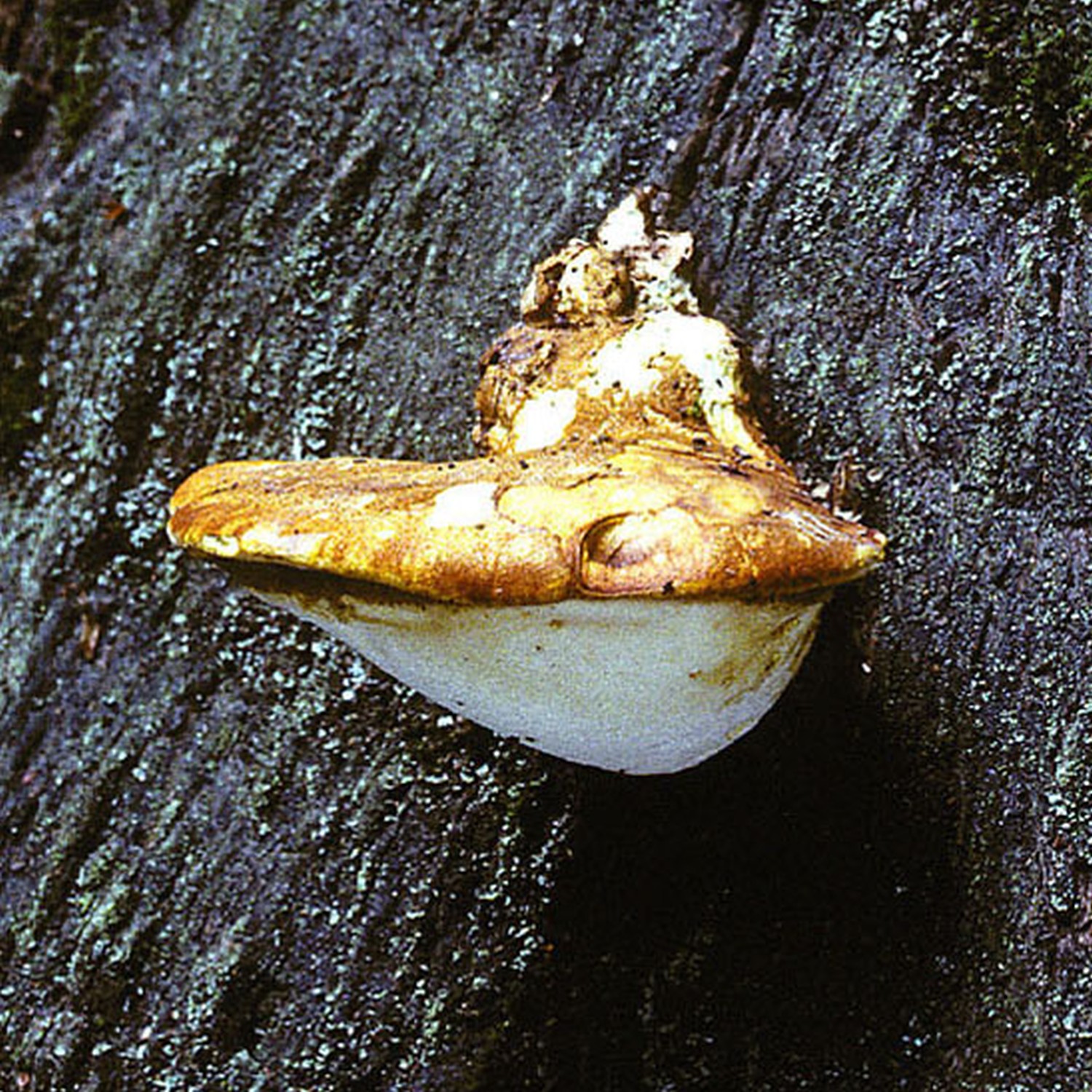 |
Buglossoporus quercinus | A bracket fungus found on the exposed heartwood of old oak trees (Quercus) often in ancient deer parks and forest pastures. | Jun-Oct (also Jan and Feb) | Scattered throughout England and Wales, more frequent in the South East, with a single site in Scotland. | 2014 | Yes | 11 | 65 | 13 | 67 |
 |
Chromosera citrinopallida | A yellow waxcap from upland dwarf-shrub heaths, deep moss, unimproved grassland, drier areas of bogs and snow beds. | Sept-Jan | Known from Scotland (S Aberdeenshire, E Ross), Northern Ireland (Antrim). Records revised with those from grassland sites in England (Mid-west Yorkshire, S Lancashire, Herefordshire) and Wales (Radnor) considered misidentifications. | 2008 | 0 | 3 | 0 | 3 | |
 |
Chromosera lilacina | A lilac to brownish orange waxcap from wet upland dwarf-shrub heaths, marshes and snow beds. | Sept-Nov | Recorded from the Cairngorms, Western Highlands and Mull in Scotland and Cheshire in England. | 2010 | Yes | 4 | 11 | 2 | 13 |
 |
Dichomitus efibulatus (= Polyporus efibulatus) | A poroid fungus causing a white rot on the dead attached wood or woody stems of blackthorn (Prunus), hazel (Corylus), gorse (Ulex) rose (Rosa) blackberry (Rubus) and hornbeam (Carpinus). | Jan-Dec | Most records are from South West England (Cornwall & Devon), but it has also been found in S. Hampshire, the Isle of Wight, Guernsey, and most recently Anglesey. | 2013 | Yes | 0 | 23 | 4 | 27 |
 |
Entoloma atromadidum | A robust dark navy blue to grey Entoloma with an often slightly wrinkled cap margin, recently segregated from the Entoloma bloxamii species concept, with smaller spores than E. bloxamii s.s. | Jul-Dec | Known from a number of sites throughout England and Wales. | NA | Described as a new species as a result of project actions | 0 | 8 | 11 | 17 |
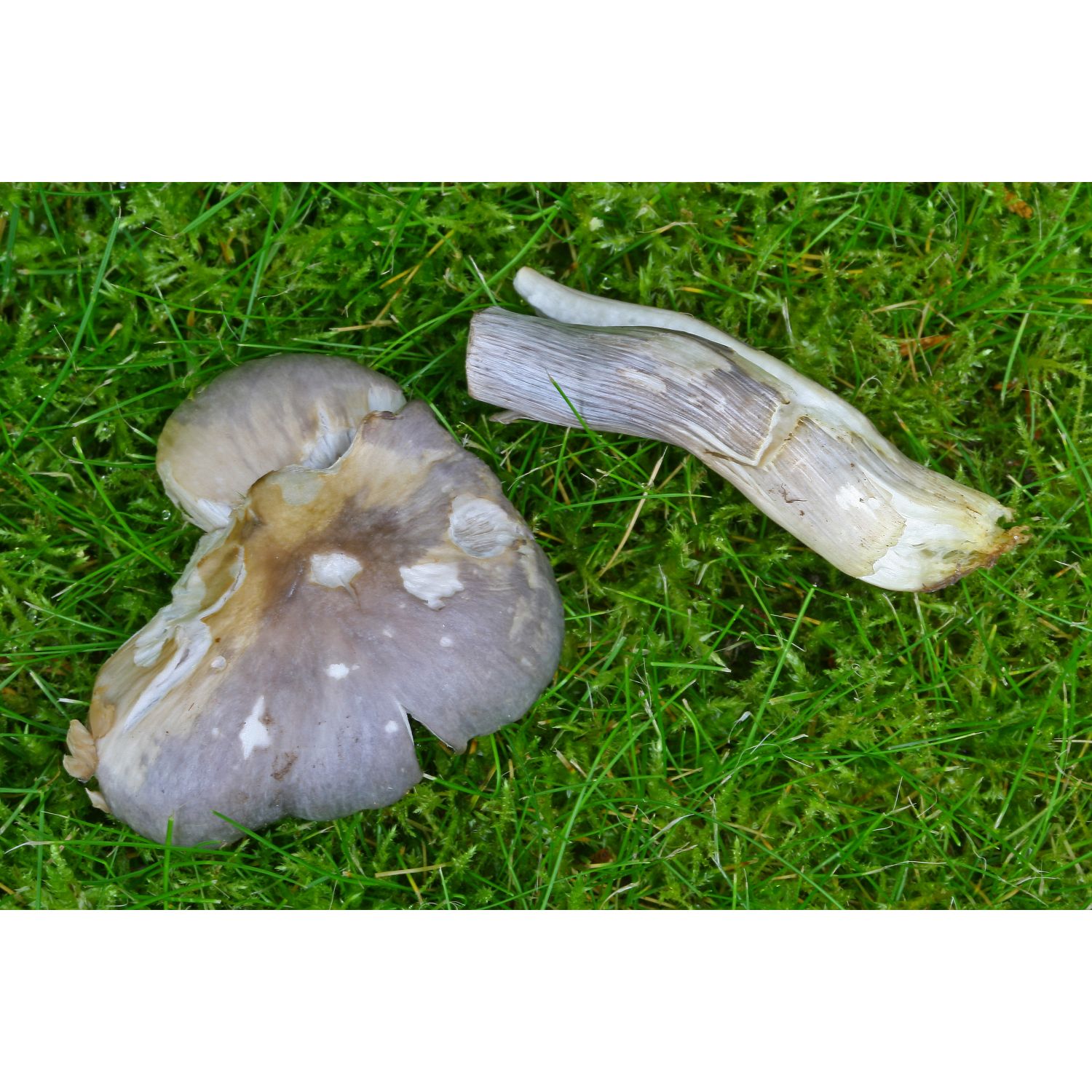 |
Entoloma bloxamii | A stout light lilac to greyish Entoloma and large (7.5-10 micron diam.) spores. Recently epityped with DNA-barcoded material to stabilise the species concept. | Jul-Dec | Confirmed from a number of sites throughout England, and one from Wales. | NA | Yes | 0 | 6 | 5 | 11 |
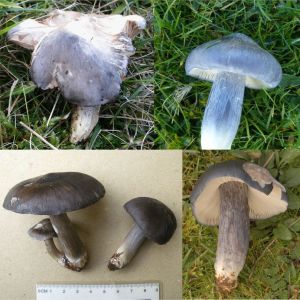 |
Entoloma bloxamii sensu lato | A stout "Big Blue Pinkgill" species concept comprising a number of biological species (E. atromadidum, E. bloxamii s.l., E. madidum and E. ochreoprunuloides f. hyacinthinum). Unresolved historical and recent records can be recorded under this name. | Jul-Dec | Recorded throughout England, Wales, Scotland and Ireland. | 2014 | Yes | 26 | 112 | 18 | 124 |
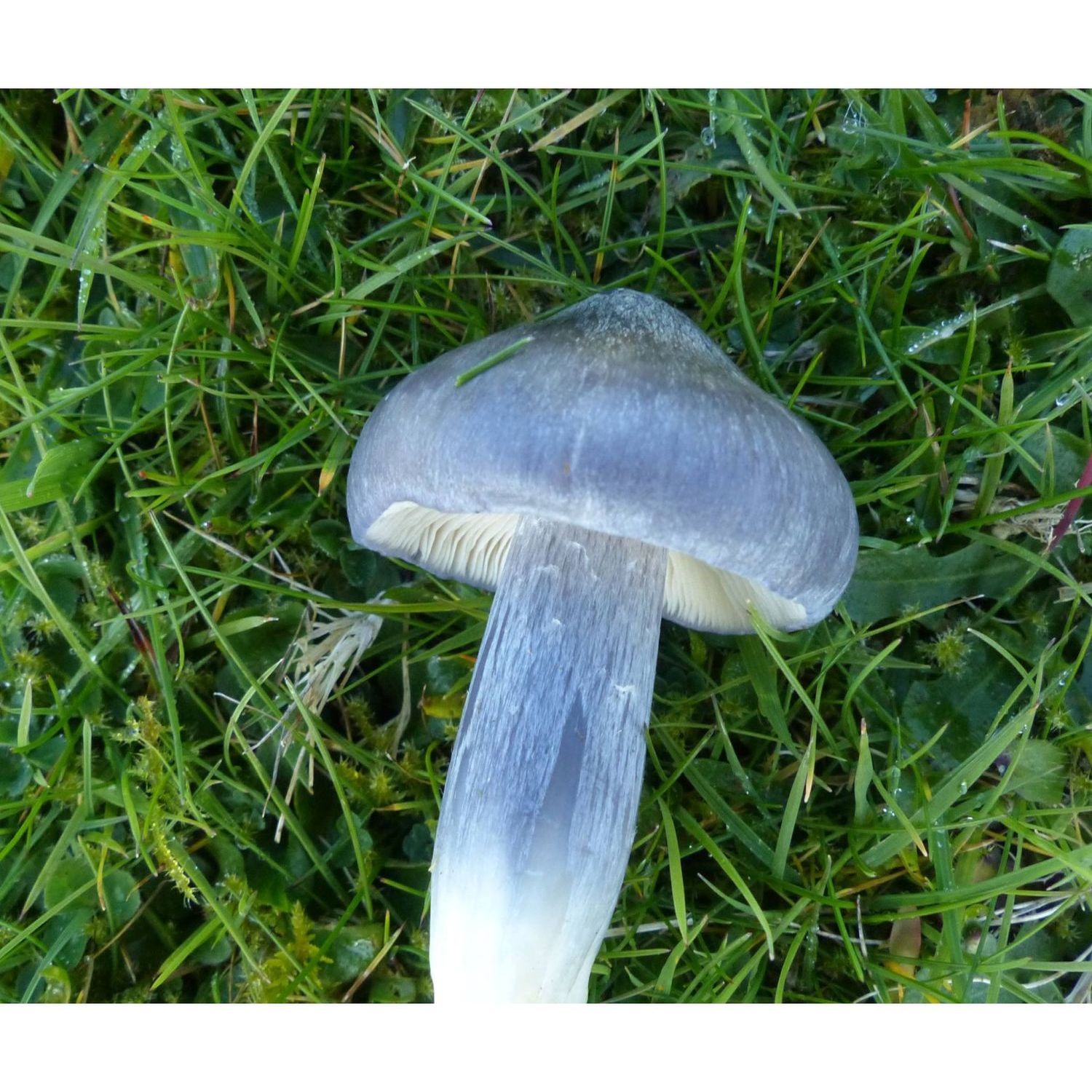 |
Entoloma madidum | A stout bright neon-to-sky blue (fading to light grey) Entoloma with smaller spores (less than 7.5 microns) than E. bloxamii s.s. Recently neotyped to stabilise the species concept. | Jul-Dec | Confirmed from a number of sites in England, Wales, Scotland and Ireland. | NA | Yes | 0 | 10 | 3 | 13 |
 |
Entoloma ochreoprunuloides and E. ochreoprunuloides f. hyacinthinum | A stout Entoloma with a variety of different colour forms, including pinkish, brownish, and brownish with violet tones (the latter being forma hyacinthinum). E. ochreoprunuloides f. hyacinthinum has historically been confused with E. bloxamii and recorded under this name. It usually has smaller spores (less than 7.5 microns) than E. bloxamii s.s. | Jul-Dec | Confirmed from a number of sites in England and Wales. | 2011 (described 2013) | Yes | 0 | 4 | 2 | 6 |
 |
Favolaschia calocera | An unmistakeable small bracket fungus growing on rotten wood | Jan-Dec | Found in a number of sites in E& W Cornwall, N & S Devon. Widespread throughout E&W Cornwall. | 2014 | Yes | 0 | 1 | 26 | 26 |
 |
Geastrum marginatum | A small earthstar found on sandy soil in coastal dunes, also recorded as Geastrum minimum (a dubious and ambiguous name globally). | Sept-Nov | Currently known from Norfolk and two sites in Cumbria | 2013 | Yes | 1 | 5 | 7 | 10 |
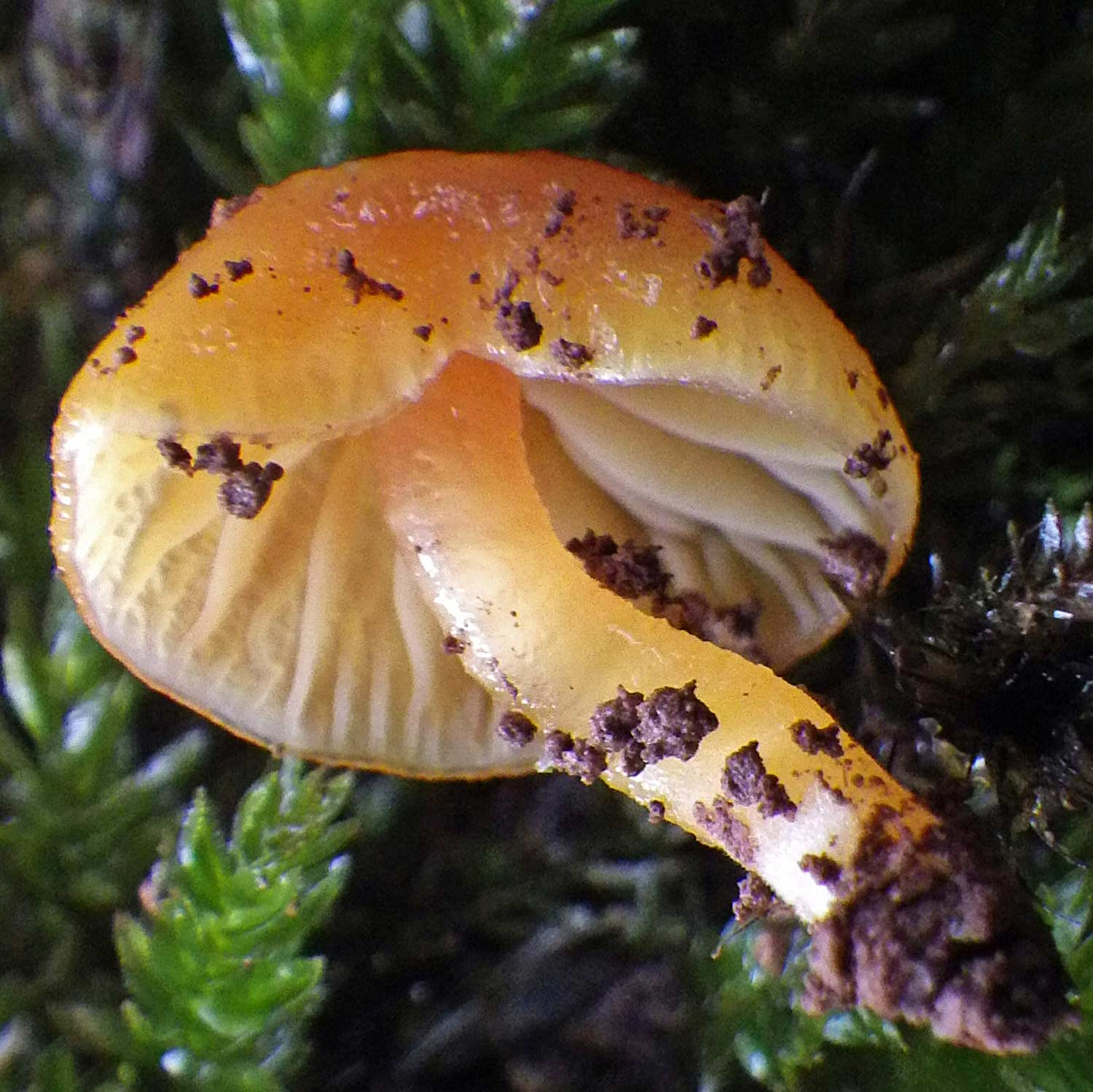 |
Gliophorus europerplexus | A reddish brown waxcap from unimproved grassland and mossy soil. Potentially endemic to Wales | Sept-Nov | Only known from two sites, in Pembrokeshire and Merioneth. Possibly previously recorded as G. perplexus (=Hygrocybe psittacina var. perplexa), although a further undescribed species is also known to be present in GB&I. | 2013 | Yes | 0 | 7 | 2 | 9 |
 |
Gliophorus reginae | A pink- to purple-capped waxcap mushroom from unimproved grassland | Oct-Jan | Recorded from scattered localities in south, central and NW England, west Wales and Northern Ireland | 2013 | Yes | 0 | 9 | 10 | 16 |
|
|
Hericium coralloides | A fungus with a white, branched, coral-like fruitbody of up to 25 cm diam., on fallen trunks and logs of Fagus sylvatica (common beech) and Fraxinus excelsior (common ash). | Aug-Dec, occasionally also Jan-Feb. | Widespread but infrequently recorded throughout south and east England, with occasional records as north as Yorkshire. A single record from Wales (in Monmouthshire VC35). | 2015 | Yes | ||||
 |
Hericium erinaceus | A fungus with distinctive white football-sized fruitbodies, formed of downward-pointing spines 10-40 mm long, fruiting high up on exposed central deadwood of old standing Fagus or Quercus trees. | Sept-Nov, with occasional records from earlier and later months. | Widespread but infrequently recorded throughout south England, with occasional records as north as Cumbria; and in Denbeighshire and Monmouthshire in Wales. | 2015 | Yes | ||||
 |
Hohenbuehelia bonii | An almost sessile (barely stalked), yellow-brown oyster mushroom growing at the base of Ammophila arenaria (marram grass). | Sept-Jan | Found in England (West Sussex and East Kent), Wales (Carmarthenshire, Pembrokeshire and Merionethshire), Scotland (East Lothian) and Ireland (Dublin). | 2012 | Described as a new species as a result of project actions | 0 | 6 | 0 | 6 |
 |
Hohenbuehelia culmicola | A small dark greyish brown to black oyster mushroom, with a well-developed stem fruiting on sand dunes near the base of Ammophila arenaria (marram grass). | Sept-Feb | Found in England (West Norfolk, North-east Yorkshire and Durham) Wales (Glamorgan and Carmarthenshire) Scotland (East Lothian) and Ireland (Dublin). | 2008 | 0 | 7 | 0 | 7 | |
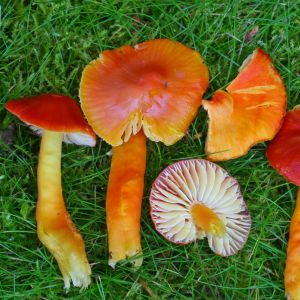 |
Hygrocybe marchii sensu Boertman edn. 1 | A Hygrocybe coccinea lookalike with smaller constricted spores, found in grasslands. | Aug-Nov | Distribution undergoing reassessment due to past confusion regarding species concepts under this name. Most records of "marchii" in other databases may be H. reidii or other taxa. | 2013 | 0 | 6 | 0 | 6 | |
| Hygrocybe roseascens | A grey waxcap with a pink tinge, found in upland pasture and hawthorn (Crataegus) scrub. | Sept-Oct | Recorded twice from a single site in Wales (Caernarvonshire). | 2011 | 0 | 1 | 0 | 1 | ||
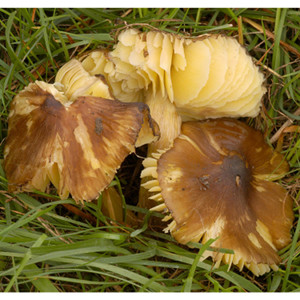 |
Hygrocybe spadicea | A brown waxcap with yellow gills, growing on unimproved grassland, often in well drained south facing situations on lime rich soil. | Jun-Nov | Scattered in England, Wales and Southern Scotland, more frequent in the west. | 2010 | Yes | 4 | 49 | 14 | 63 |
 |
PDF - Species Datasheet |
One of the few lichenized basidiomycetes in the UK, with brightly coloured club-shaped fruit-bodes | Mar-Aug | England (N Hampshire), Scotland (N Harris, W Lewis, Shetlands). Unsuccessful searches at the Shetland and N. Harris localities, | 2011 | Yes | 1 | 4 | 2 | 6 |
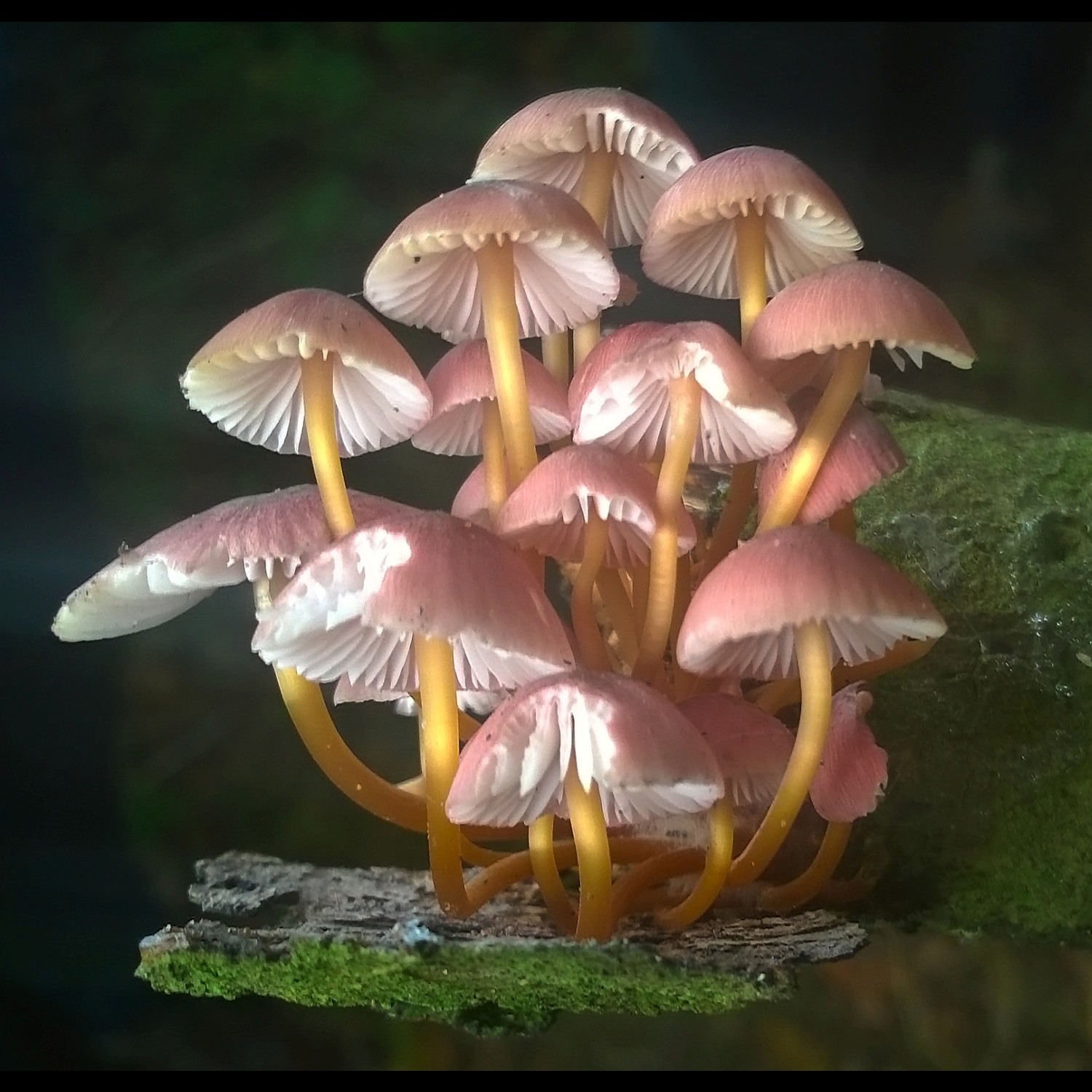 |
Mycena renati | A reddish to pinkish-brown gilled fungus with a yellow stem, growing in groups or clusters on the dead wood of broadleaved trees. | Jun-Oct | Only recorded from England. Recent records are from West Sussex and Lincolnshire. | 2002 | Yes | 5 | 5 | 3 | 7 |
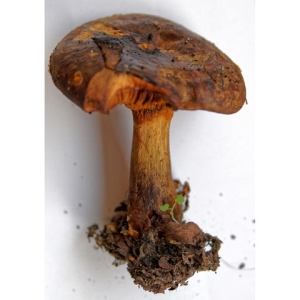 |
Paxillus cuprinus | A light brown to dark coppery-brown gilled fungus found in open sunny places with birch (Betula) alder (Alnus) and hazel (Corylus). | Aug-Nov (also May, possibly May-Nov) | Currently only recorded in the UK in England (N E Yorkshire, Surrey and Middlesex) but likely to be widespread. | 2014 | Yes | 0 | 1 | 17 | 18 |
|
|
Perenniporia ochroleuca | A small bracket fungus on branches of dead wood of mainly on blackthorn (Prunus spinosa) but also hawthorn (Crataegus monogyna), and other hosts, in coastal areas. Distinctive due to its very distinctive, fine and regular pores. | Jan-Dec | Throughout Cornwall, along the south coast of England, Pembrokeshire, and the Channel Islands. | 2014 | Yes | 0 | 24 | 42 | 58 |
 |
Podoscypha multizonata | A fungus forming distinctive brown to reddish rosettes, usually near the base of beech or oak trees in parkland or woodland. | July-Nov | England where it is widespread but infrequently recorded, with only two records from Wales and a single historical record from Scotland. Of conservation concern because England hosts a large proportion of the global population. | 2014 | Yes | 17 | 68 | 26 | 72 |
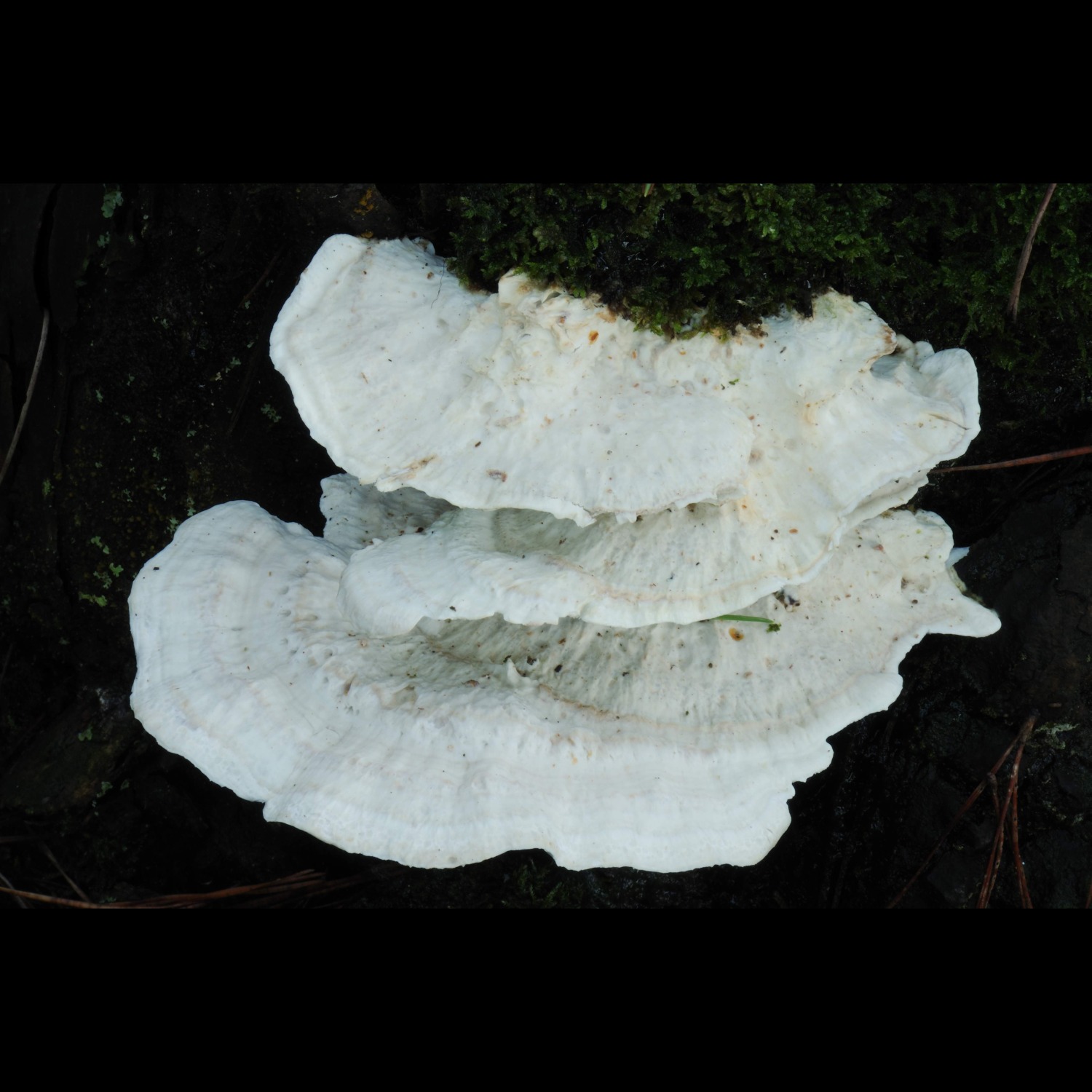 |
Postia guttulata | A white bracket fungus exuding drops of liquid when young, found on the wood of conifers including spruce (Picea) and cedar (Cedrus). | Jul-Nov | Recorded from England (Shropshire, Herefordshire, S Hampshire, Surrey and E Sussex). | 2013 | Yes | 1 | 5 | 11 | 14 |
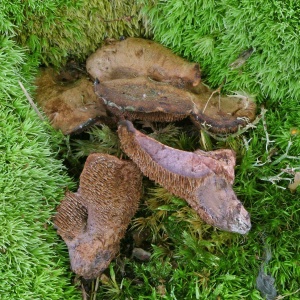 |
Sarcodon joeides | An ochre brown to reddish beige toothed fungus, in moss and leaf litter on lime rich soil with sweet chestnut (Castanea sativa) beech (Fagus) and oak (Quercus). | Sept | Known from single sites in Berkshire, West Kent, and South Devon. | 2010 | Yes | 0 | 1 | 2 | 3 |
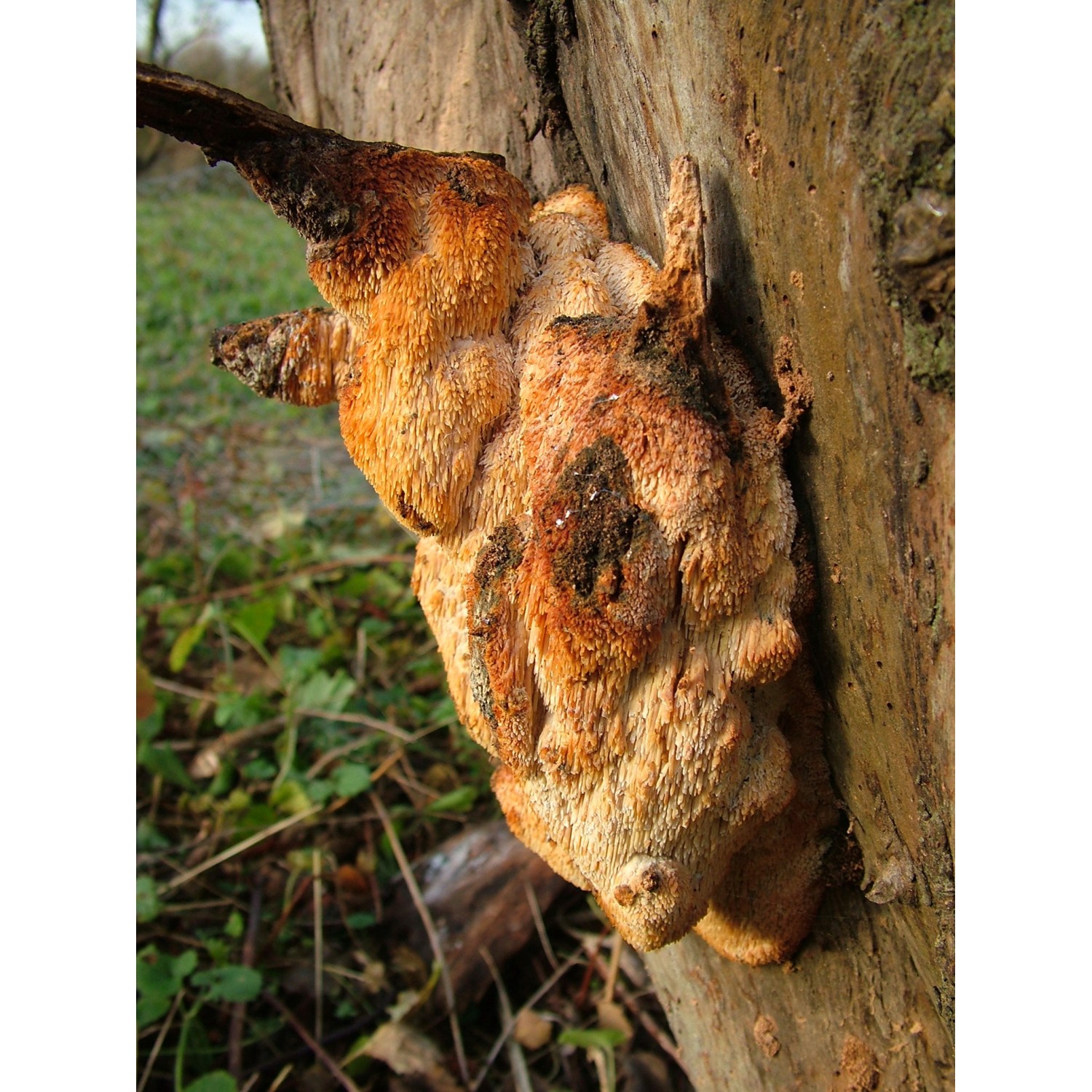 |
Sarcodontia crocea | A yellowish resupinate tooth fungus found on mature fruit trees, mostly on apple (Malus) but sometimes pear (Pyrus) and Prunus species. | Jul-Nov, also Feb. | Throughout England, more frequent in the South East. | 2013 | Yes | 10 | 22 | 10 | 32 |
 |
Simocybe centunculus var. maritima | A small mushroom currently treated as a variety of Simocybe centunculus (dingy twiglet), but associated with dead leaf bases of Ammophilia arenaria (marram grass). | Oct-Nov | In Britain, known only from single records from Anglesey, Cardiganshire, Pembrokeshire and Glamorgan. | 2006 | Yes | 0 | 3 | 1 | 4 |
 |
PDF - Species Datasheet |
A minute stalked puffball in moss patches on top of limestone boulders | Apr-Dec | Only known from the Inchnadampf area (W Sutherland) (two main sites and three more distant sites from single records); a widespread population at Craig Leek SSSI in S Aberdeenshire; and a new site in Lismore, Argyll. | 2013 | Yes | 0 | 7 | 3 | 8 |
 |
Volvariella aethiops | An unusual Volvariella with deep sepia-brown to blackish-brown fibrillose cap and stipe, and thick and brownish white volva, possibly parasitic on Agaricus xanthodermus (the "yellow stainer"). | Oct-Dec | Only known from Lullingstone Park (West Kent) and RBG Kew (Surrey). | 2010 | Yes | 0 | 1 | 1 | 2 |
| Xerocomus silwoodensis | A boletoid fungus with a reddish brown cap and red reticulation on the stem, in damp shaded areas with poplar and aspen (Populus) trees. | Jun-Oct | England (Hertfordshire, Berkshire, Hampshire) | 2010 | 0 | 3 | 0 | 3 | ||
